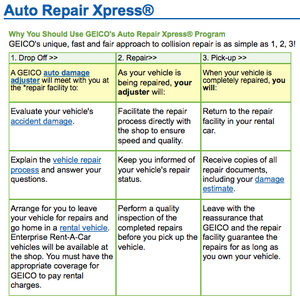
Auto insurance customer experience
How to turn a fender bender into a good experience
A few weeks ago a woman backed her SUV into my driver’s side door. Not an ideal turn of events as I was in the car, but she wasn’t moving fast enough to cause injury or even much damage to my car. She was so nice and felt so bad that I couldn’t even get upset. A quick exchange of insurance details and I was on the way back to my office, dreading the thought of how much time it would take to repair the fairly insignificant dent.
 Luckily, both of us were insured with Geico and I called them on my way home. What transpired over the next couple weeks was probably one of the most flawless customer experiences I have ever seen. I only made the first phone call to Geico and they called me to initiate every other step of the process. They set up my appointment with Alioto’s Repair Shop (just about 8 minutes from my house). When I got there, Geico’s adjuster was waiting there to meet me and approve the repair and pass me over to Enterprise, which had a rental waiting. After a couple status updates from Alioto’s, I traded the rental for my newly repaired car about 5 days later—earlier than expected. This partnership with approved garages is apparently a new Auto Repair Xpress Service they’ve rolled out in the last several months—and they’re getting great feedback from their customers.
Luckily, both of us were insured with Geico and I called them on my way home. What transpired over the next couple weeks was probably one of the most flawless customer experiences I have ever seen. I only made the first phone call to Geico and they called me to initiate every other step of the process. They set up my appointment with Alioto’s Repair Shop (just about 8 minutes from my house). When I got there, Geico’s adjuster was waiting there to meet me and approve the repair and pass me over to Enterprise, which had a rental waiting. After a couple status updates from Alioto’s, I traded the rental for my newly repaired car about 5 days later—earlier than expected. This partnership with approved garages is apparently a new Auto Repair Xpress Service they’ve rolled out in the last several months—and they’re getting great feedback from their customers.
So, why is a communications consultant writing about her car repairs? Because what took this experience from good to excellent was the frequency and quality of the communication. Geico’s phone and email communication set clear expectations, covered all the necessary details and made me feel confident from the start. Alioto’s had an easier job of just keeping me posted on the repair, but they also set clear expectations of when and how I’d hear from them and followed through. Both were surprising in their attention to detail and how obvious it was that they already knew all the questions I would ask.
Anticipating questions and concerns of your audience is fundamental to good communication, but often gets overlooked. Burying all of those questions and concerns in an FAQ document is not good enough. Good communication addresses your audiences’ needs up front—so that they are not left with any unanswered questions.
Work with Us
We partner with organizations that value their people first. Let’s talk.

Jennifer Benz, SVP Communications Leader, has been on the leading edge of employee benefits for more than 20 years and is an influential voice in the employee benefits industry.
